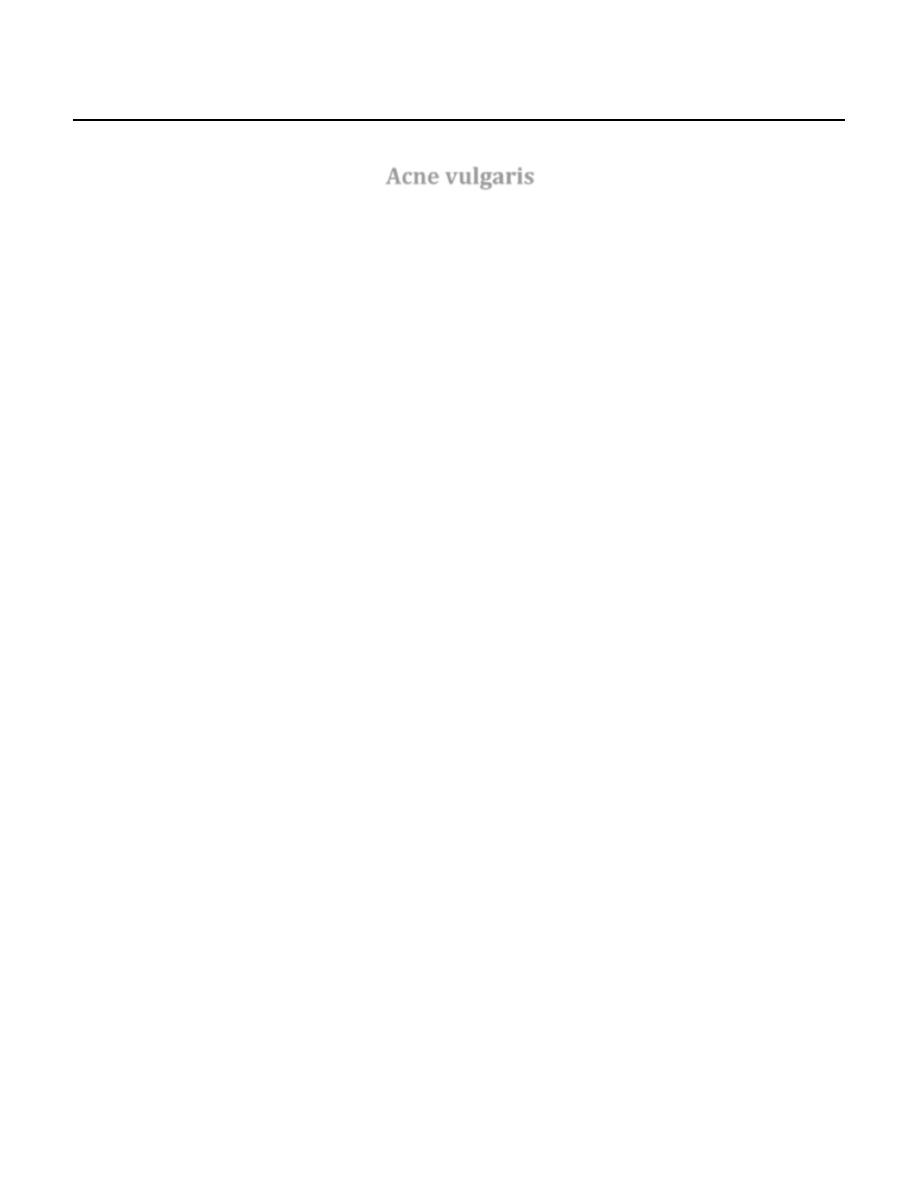
1
Fifth stage
Dermatology
Lec. 6
د. منار
24/11/2016
Acne vulgaris
Acne Vulgaris
• Acne is a chronic inflammatory disorder of the pilosebaceous unit.
• It is a polymorphic disorder (comedons, papules, pustules, nodules,
pseudocysts, and sometimes scarring)
• The sites of predilection are face, upper trunk and upper arms.
• It usually affect adolescent
• Darker skinned patients at increased risk for developing post-inflammatory
hyper-pigmentation and keloids.
• Patients can experience significant psychological morbidity and, rarely,
mortality due to suicide.
Prevalence
Acne may be the most frequent reason for seeing a dermatologist, over 90% of
males and 80% of females are affected during their teen age.
Age of onset
Acne develops earlier in females than in males that may reflect the earlier onset of
puberty. Mean age at onset of acne was 12 ± years in girls and 15± years in boys.
Etiology and Predisposing factor
• Family and genetic history
• Excessive production of sebum
• Endocrine factor: androgen, premenstrual exacerbation
• Microflora (propionobacterium acne) anaerobic
• Diet
• Mechanical (post epilation)
• Psychological and emotional
• Topical drugs and agents: oily cosmetics, some chemicals, use of anabolic
steroids
• Puberty and menstrual cycle
• Humidity and excessive sweating
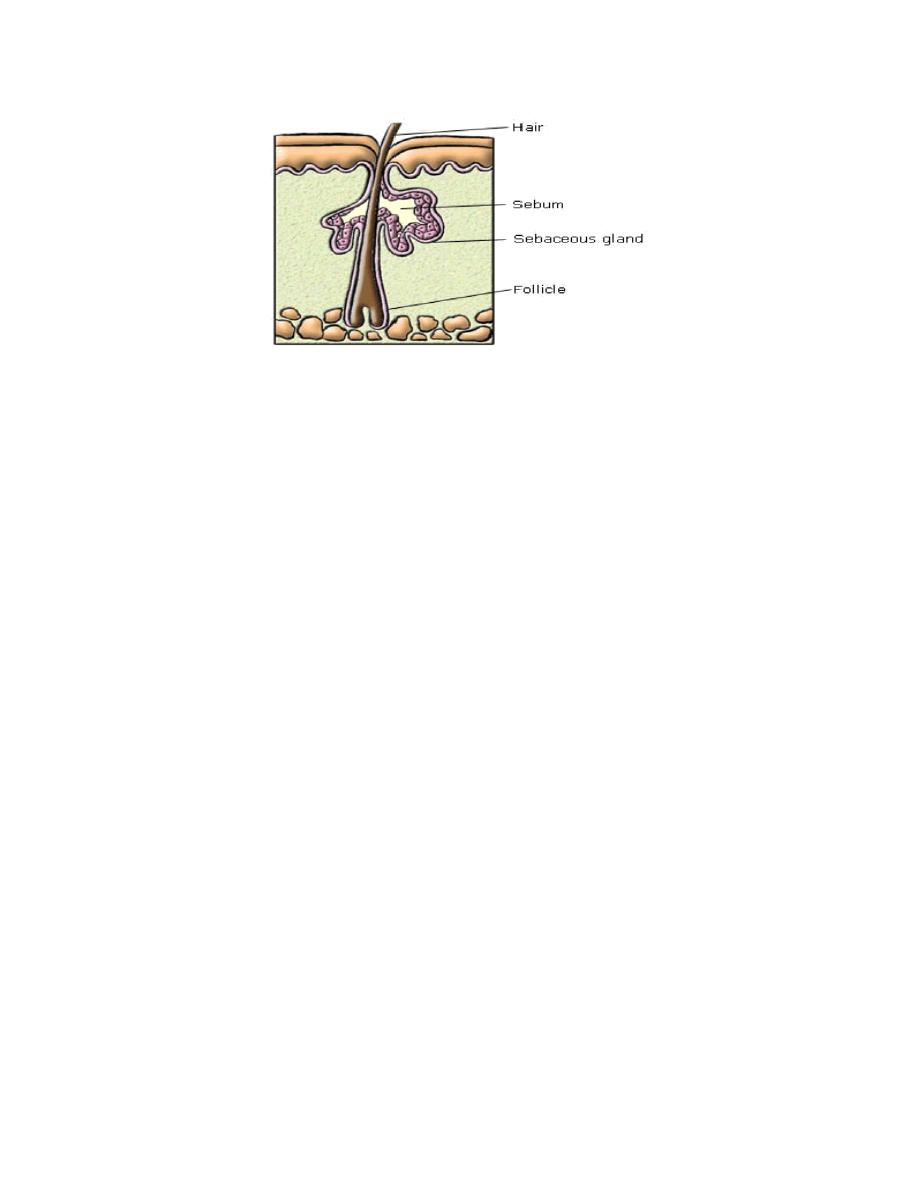
2
Normal hair follicle
Pathophysiology
Follicular keratinocytes exhibit increased cohesiveness (do not shed normally)
↓
Leading to retention and accumulation of sebum.
↓
Androgens stimulate enlargement of sebaceous glands and increased sebum
production
The abnormal keratinaceous material and sebum collect in the microcomedon. (So
commedon formed which is non-inflammatory acne)
↓
Bacterial proliferation (Propionibacterium acnes)
↓
Infection and inflammation
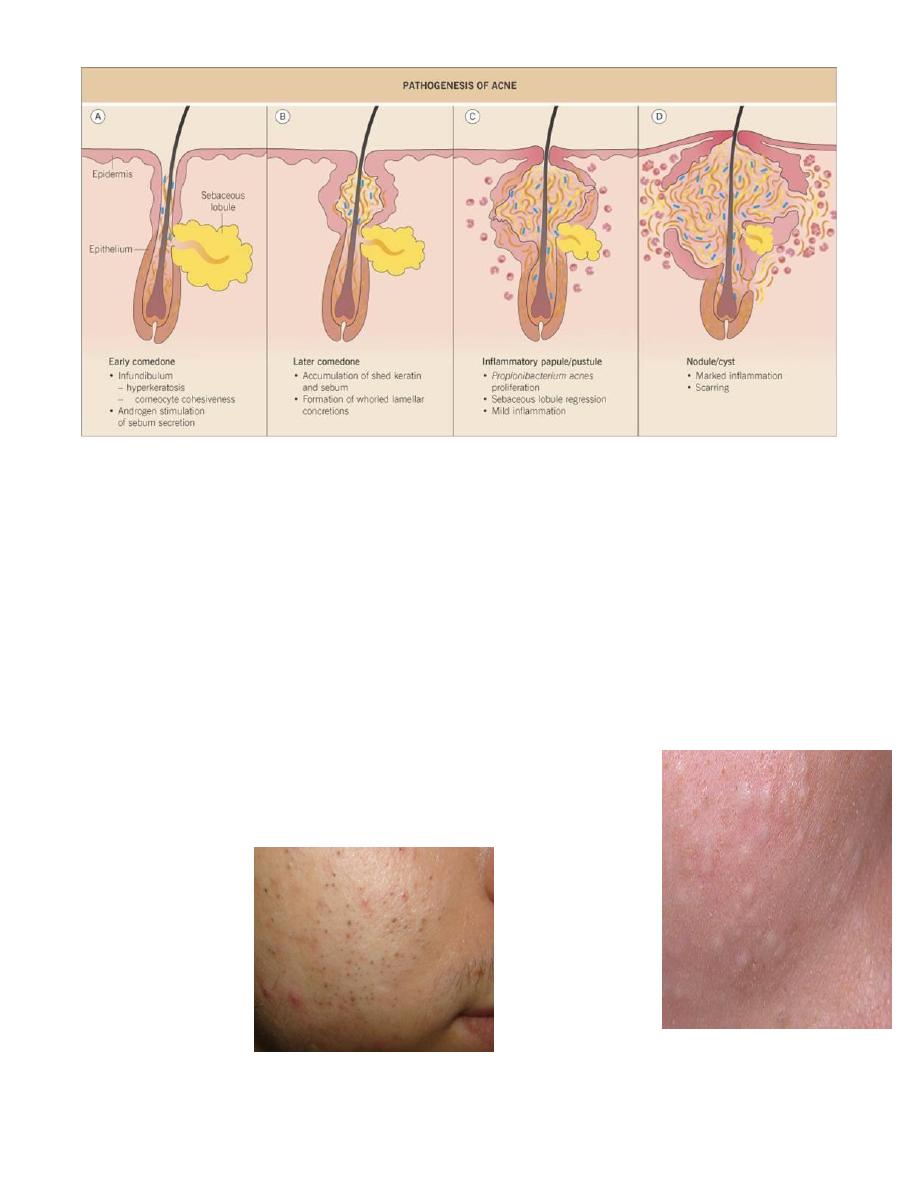
3
The types of lesions in Acne:
A. Non inflammatory lesions: (comedones) which consist of:
• White heads (closed comedones).
• Black heads (open comedones).
B. Inflammatory lesions include:
• The superficial lesions are usually papules and pustules.
• The deep lesions are deep pustules, nodule, pseudocysts & Sinuses
Clinical types
Closed comedone (white head): a clogged follicle, most resistant to treatment.
Whiteheads usually appear on the skin as small, round, white bumps.
Open comedone (black head): a plugged follicle that opens and
turns dark at the surface of the skin due to deposition of
melamine (do not indicate the presence of dirt.
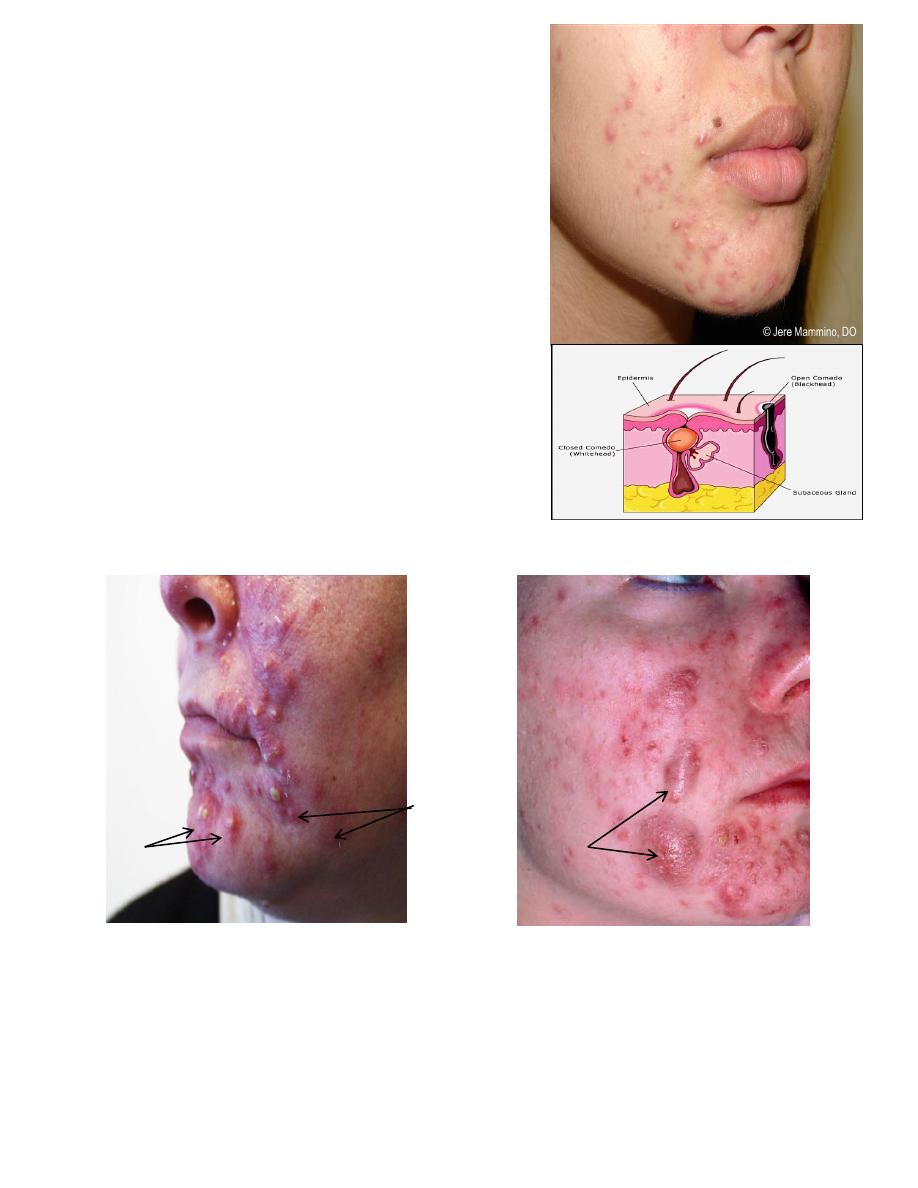
4
Papules: inflamed lesions that appear as small, pink
bumps on the skin.
Pustules (pimples): inflamed pus filled lesions that
are red at the base.
Cysts and nodules large, inflamed, pus filled lesions
deep under the skin that can cause pain and scarring.
Pustule
Papule
Cyst

5
Acne Varients
• Neonatal acne
• Persistant acne
• Late onset acne (chin of female)
• Acne conglobata (nodulocystic acne)
• Fulminante acne (fever + acne)
• Acne excorié (hair epilation)
• Gram negative folliculitis. ( S.E. of tetracycline )
• Cosmetic Acne (make up)
• Drug induced acne (steroid acne)
• Endocrine acne
Neonatal acne Steroid acne
Post-inflammatory erythema
Atrophic scar
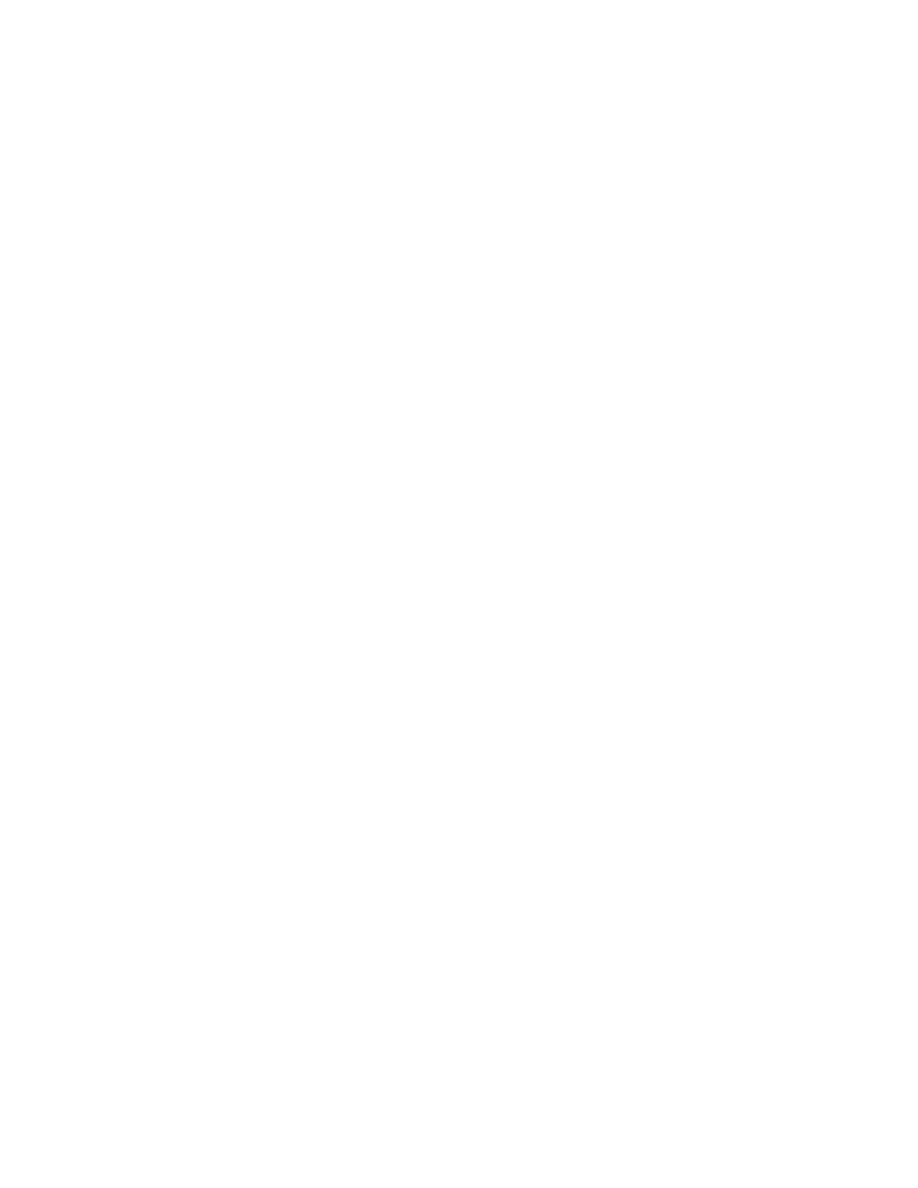
6
Steroid Acne
1. History of steroid drugs use
2. No comedones
3. Wide spread
4. Rapid oncet
5. Monomorphic
Local symptoms: Pain especially if acute inflammation
Systemic symptoms: Most often absent
Classification according to severity:
• Comedonal acne: Only comedons
• Mild acne: Less than 20 pustules.
• Moderate to severe acne: More than 20 pustules (Sever acne contain cysts,
sinuses, scaring)
Complications of acne:
1. Scarring.
2. Psychological impact.
Ddx:
1. Rosocea
2. Perioral dermatitis (in females 30-50 years who use topical steroid)
3. Pitrosporum folliculitis
4. Folliculitis barbae and Psudofolliculitis barbae
5. Acne form drug eruption
6. Acne form secondary syphilis
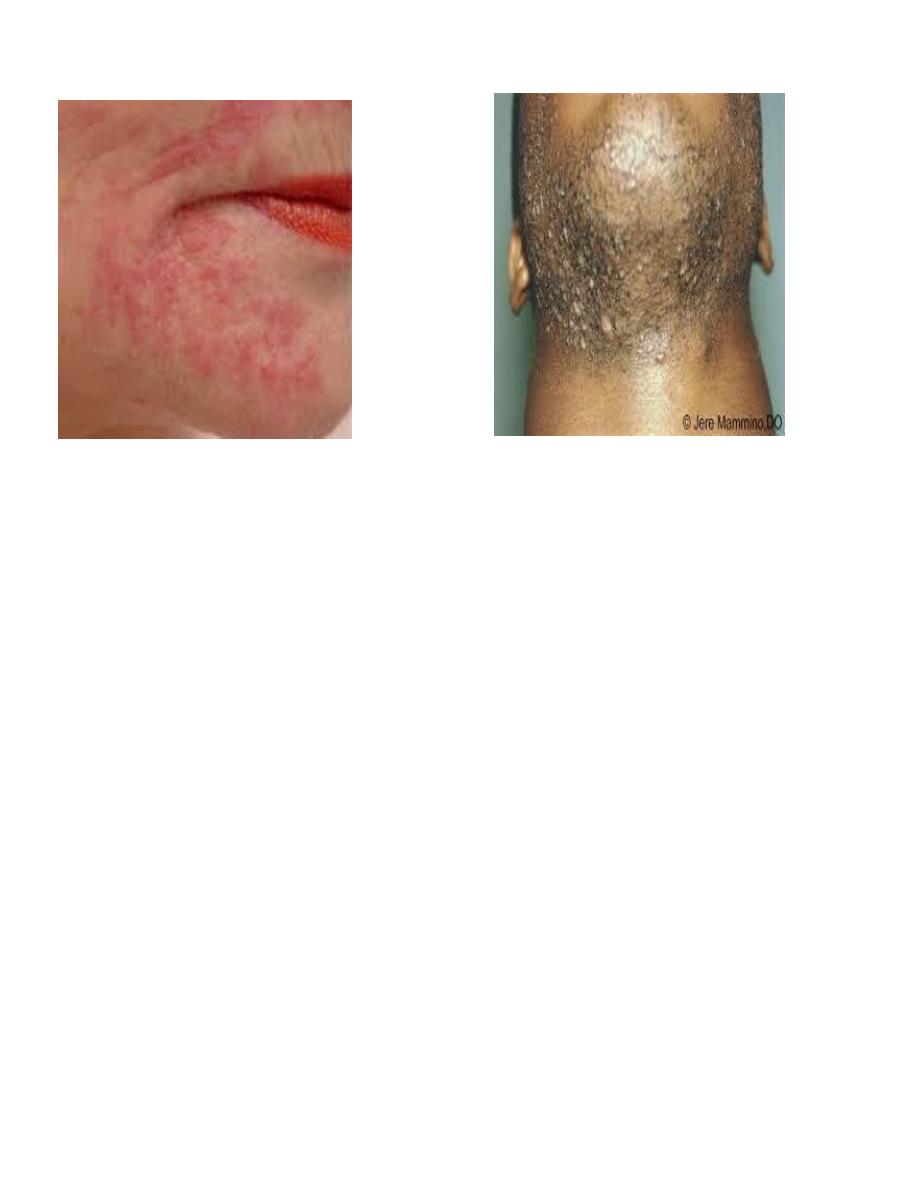
7
Perioral dermatitis Psudofolliculitis barbae
Treatment
A. General measures.
B. Topical treatment.
C. Systemic therapy.
The choice of therapy
• Mild acne: topical therapy.
• Moderate acne: topical and oral therapies.
• Severe acne: isotretinoin unless it is contraindicated.
A. General measures:
• Improve hygiene
• Gentle cleansing
• Avoidness of comedogenic applications.
• Reassurance
B. Topical treatments:
1. Those directed towards microorganisms.
2. Those directed towards comedogenesis.
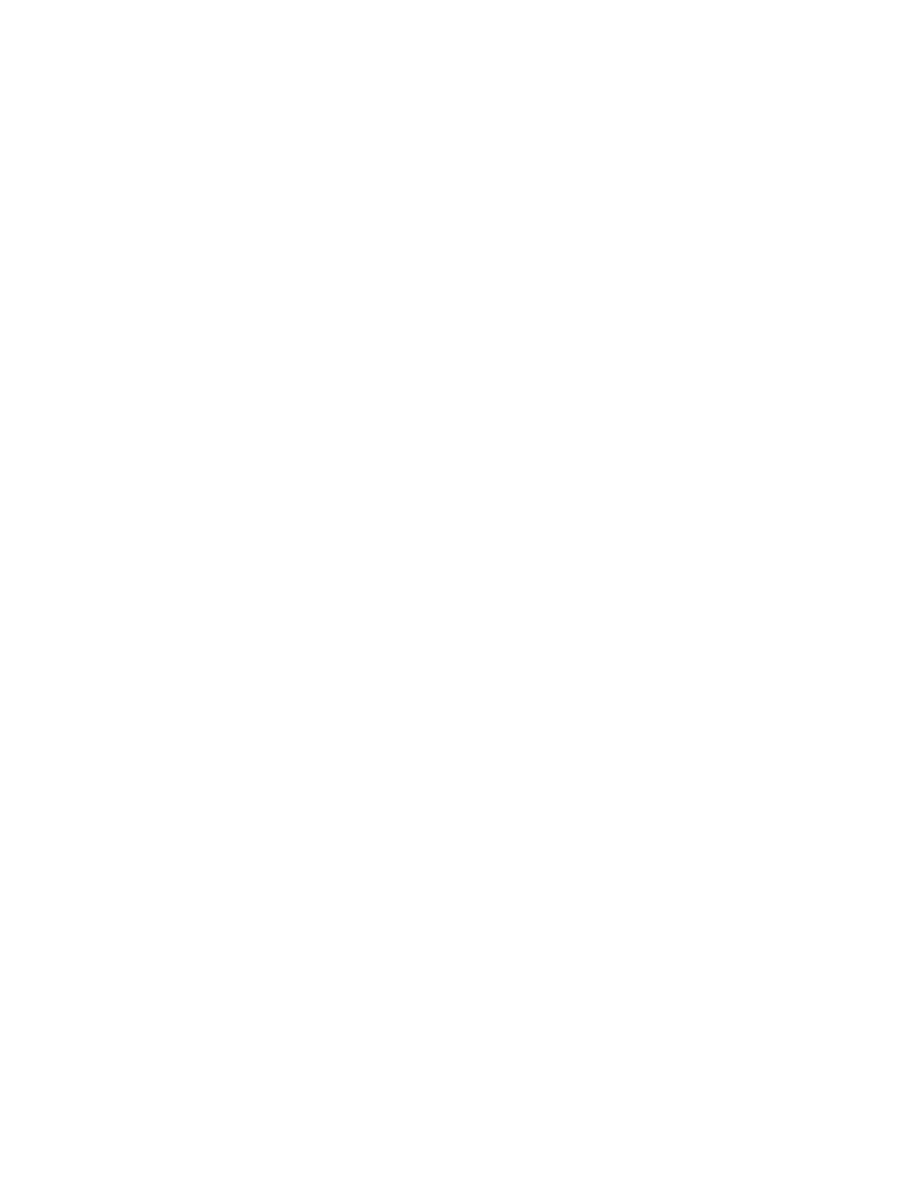
8
1. Topical treatments directed towards microorganisms:
Topical antibiotics: erythromycin (1.5-2% gel or cream), clindamycin (1%
lotion), Benzyl peroxide.
2. Topical treatment directed towards comedogenesis:
• Retinoids:
Anti-seborrheic effect
Anti-comedonal effect
Anti-inflammatory effect
Inhibiting the growth of propionobacterium acne
- Tretinoin may be used as solution, cream or gel. It is available in
0.025% , 0.05% and 0.1% concentration
- Tazarotene (0.1% gel) applied once daily.
- Adapalene: Adapalene (0.1% gel).
• Azelaic acid: cream with 20%
C. Systemic Treatment of acne:
1. Those directed against microorganisms (antibiotics).
2. Those directed against comedogenesis and seborrhea (retinoids).
3. Those acting on hormonal bases (antiandrogens).
1. Systemic antibiotic
Indications
• Moderate or severe inflammatory acne.
• Acne resistant to topical treatment.
• Acne that covers large area of the body.
Tetracycline: Tetracycline dose for an adult is 250 mg four times daily.
Doxycycline: It is usually given in a dose of 100 mg once or twice daily.
Minocycline: The usual dose is 50-100 mg once or twice daily.
Erythromycin and Azithromysin
Clindamycin: In a dose of 75-150 mg. (may cause pseudomembranous colitis)
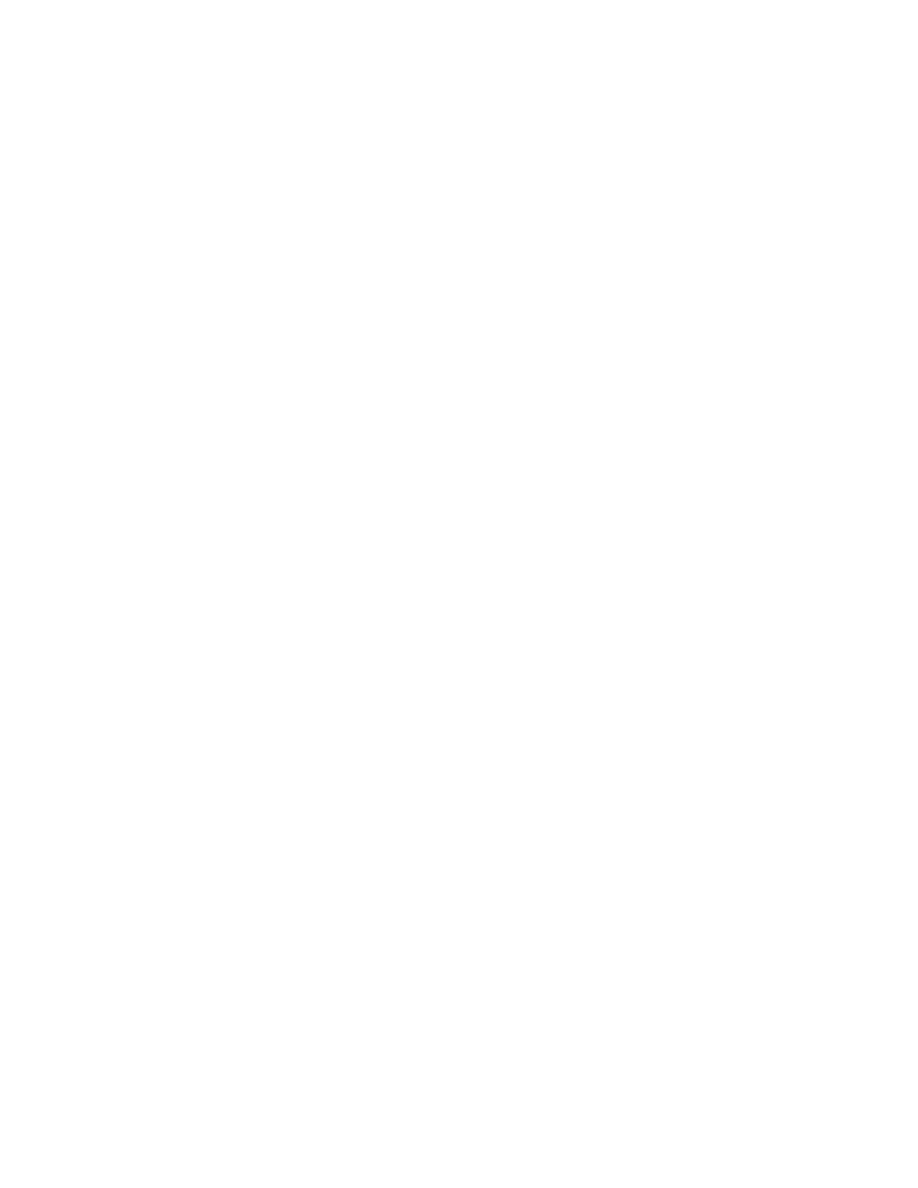
9
2. Isotretinoin (Vitamin A derivative): is the single most effective treatment.
Indications:
• Severe acne.
• Moderate unresponsive acne.
• Acne with scarring.
• Acne with severe depression or dysmorphophobia.
• High sebum excretion rate.
• Some unusual variants, such as acne fulminans, gram-negative folliculitis.
Side Effect of Isotretenoin
• Teratogenic (contraindicated to be pregnant)
• Dryness of skin and mucous membrane (lip, face, and body nose – bleeding)
• Conjunctivitis
• Hair loss
• Impetiginization
• Photosensitivity
• Arthralgia and myalgia
• Depression
• Headache
3. Hormonal therapy
Indicated for:
Acne is not responding to conventional therapy.
If there are signs of hyperandrogenism (PCOS, Hirsutism)
A. Androgen production inhibitors
Glucocorticoids and oral contraceptives
B. Androgen receptor blockers: cyproterone acetate, spironolactone and
flutamide.
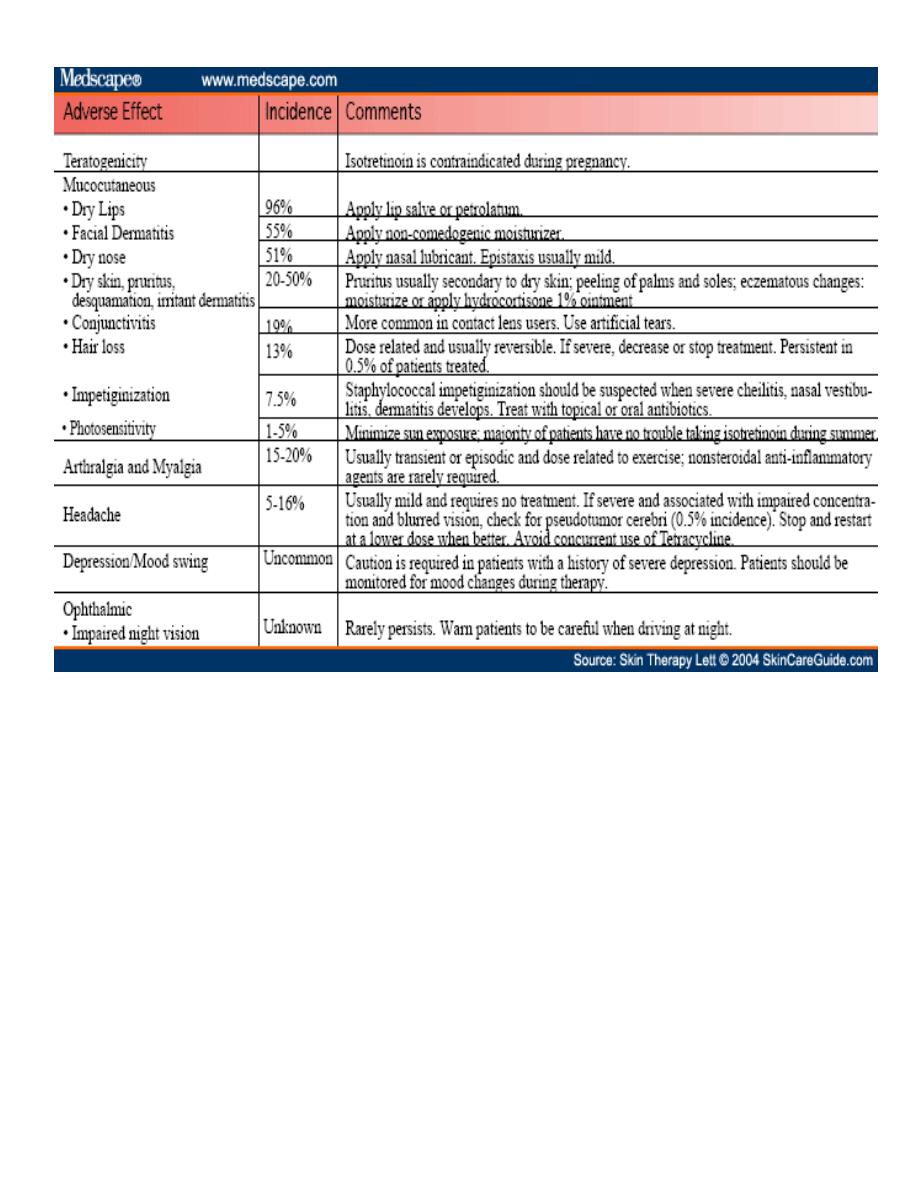
10
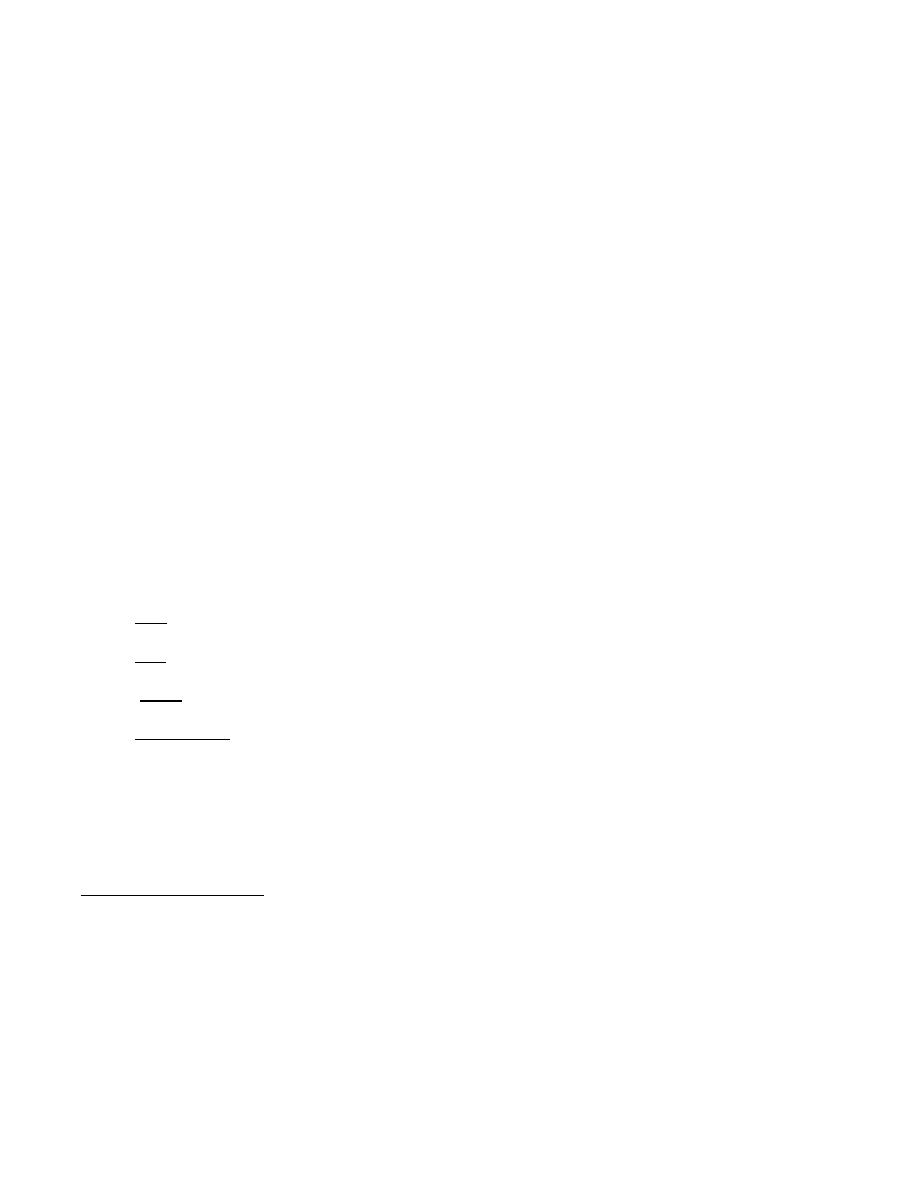
11
Rosacea:
داء
الوردية
Rosacea
(latin: “like roses”) is a chronic inflammatoy disorder of the facial
pilosebaceous units, with an increased reactivity of capillaries to heat, leading to
flushing and telangiectasia...
Clinically
Stages of evolution
Episodic (flushing) in response to (hot liquids), spicy foods; alcohol ,exposure to sun, heat
and emotional stress.
Stage i: persistent erythema with telangiectases
Stage ii: persistent erythema, telangiectases, papules, tiny pustules
Stage iii: persistent deep erythema, dense telangiectases, papules, pustules, nodules;
•
marked sebaceous hyperplasia edema of the central part of the face
"glandular rosacea“ causing disfigurement of the nose (Rhinophyma) (enlarged nose) }
• Age of incidence between 30 to 50 years,
• Sex females predominantly;
• Race WHITE peoples.
• Distribution characteristic is a symmetrical localization on the face
Eye lesions “red” eyes :
Chronic blepharitis, conjunctivitis, and episcleritis. Rosacea keratitis
Differential diagnosis
• Acne: (note: in rosacea no comedones)
• Perioral dermatitis
• Folliculitis
• SLE ( no papule and pustule )
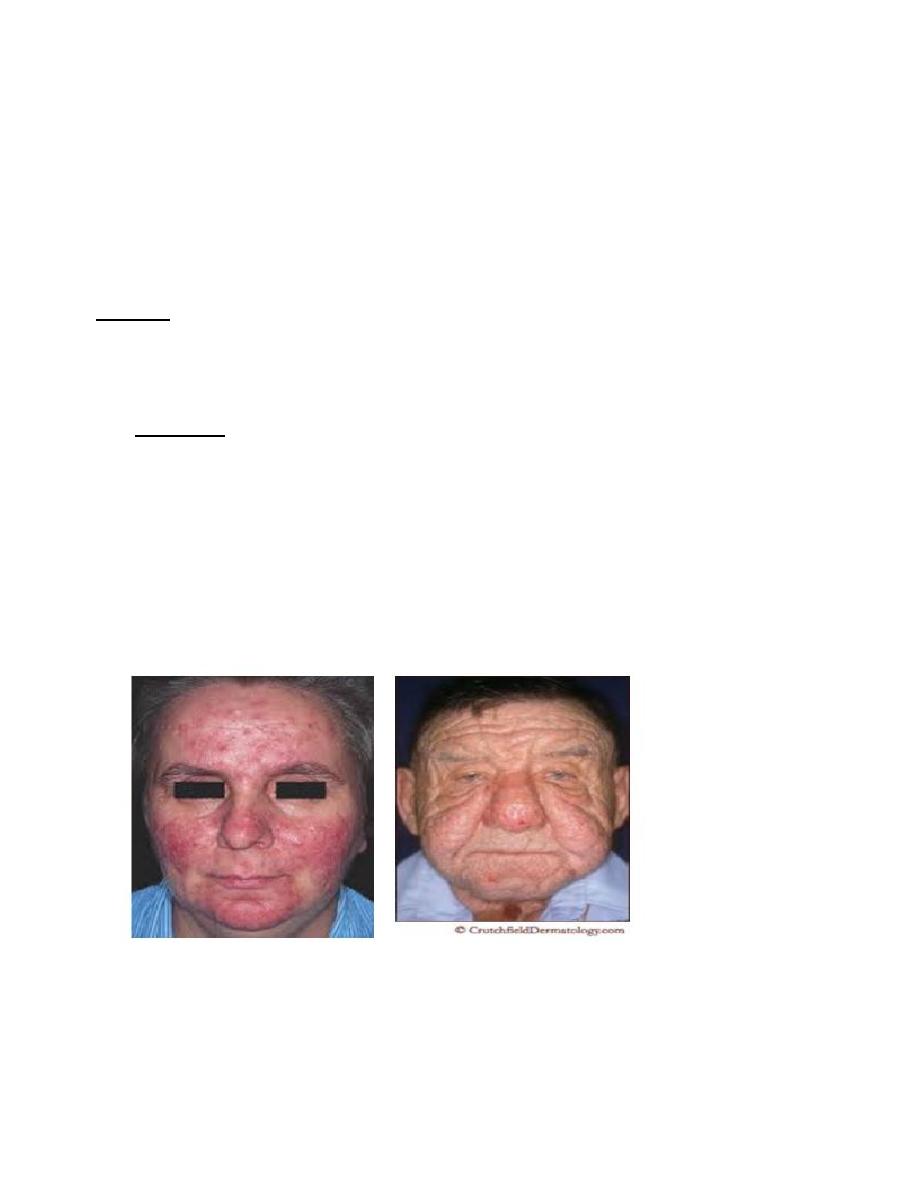
12
Course :
• Prolonged.
• Recurrences are common.
• After a few years, the disease tends to disappear spontaneously.
Management
Reduction of alcoholic and hot beverages.
Topical :
• Metronidazole gel or cream, 0.75 %, twice daily
• orTopical antibiotics (e.g., erythromycin gel).
• Systemic: oral antibiotics:
• Tetracycline, 250mg 4td. until clear; then gradually reduce to once-daily doses of 250 to
500 mg.
• Minocycline and doxycycline: 50 to 100 mg twice daily.
• Oral Isotretinoin
• Rhinophyma, is treated successfully by surgery or laser surgery.
